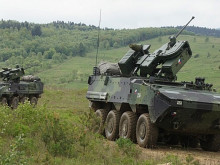The Czech Army is expanding its capabilities in detecting Unmanned Aerial Vehicles
Modern unmanned systems are playing an increasingly important role in today's conditions. However, the easy availability and ease of use of Unmanned Aerial Vehicles of various categories also brings with it the risk of their misuse. Findings from current armed conflicts also draw attention to this fact. The ability to detect such a threat in a timely manner gives a key advantage and the ability to act effectively against it. Therefore, the Army of the Czech Republic does not underestimate this area and considers it very important. At the end of April, the CW (Continuous Wave) Trial exercise took place, in which several specialized units of the Czech Army with various types of Unmanned Aerial Vehicles and two VERA-NG sets took part.
 Picture: VERA-NG radar system | ERA Pardubice / CC BY-NC-ND
Picture: VERA-NG radar system | ERA Pardubice / CC BY-NC-ND
As part of the delivery of a new passive system DPET (Deployable Passive ESM Tracker) for the Army of the Czech Republic, one of the newly acquired capabilities is the detection of devices using continuous carrier waves (CW - Continuous Wave) signals used mainly in the field of data communications. It is used by both Unmanned Aerial Systems (UAS) and modern radio communication equipment. Continuous waves are increasingly the domain of radar systems. "Testing of the ability to detect CW devices using the DPET system supplied by ERA a. s. took place at the end of April this year as part of the CW Trial exercise in the Nepolisy area and in the Libavá Military District," Lt. Col. Lukáš Macek says and adds that the aim of testing was primarily to verify the required capabilities declared by the manufacturer. Previous measurements have shown that the VERA-NG system, which belongs to the DPET category, is able to detect and guide UAS over a distance of tens of kilometers.
This fact was confirmed during exercises during weekly testing in a real environment using Unmanned Aerial Vehicles introduced in the Czech Army. Unmanned Aerial Vehicles of the "MICRO" and "MINI" categories introduced in the Czech Armed Forces, as well as the commercial UAS (DJI MAVIC) were involved, and the ability to detect and locate the SQUIRE battle radar and the altimeter of the MI-171Š helicopter was also tested. "During the testing itself, both separate flights of individual devices and simultaneous flying of different types of UAS were performed, which, among other things, tested the ability to detect and distinguish unmanned vehicles carried by the DPET system in parallel. All Unmanned Aerial Vehicles were detected by the passive system immediately after takeoff and monitored throughout the flight," Lt. Col. Lukáš Macek states. "It was crucial for us that the technology of passive systems proved to be a clearly promising solution for the detection and monitoring of unmanned vehicles in the tests." Thanks to the delivery of the DPET system the Army of the Czech Republic will thus expand its capabilities for early detection of threats in the form of Unmanned Aerial Vehicles. In cooperation with the manufacturer, other tests will be carried out as part of the preparation for the conduct of DPET military tests in 2022.
Source: Ministry of Defense of the Czech Republic




















